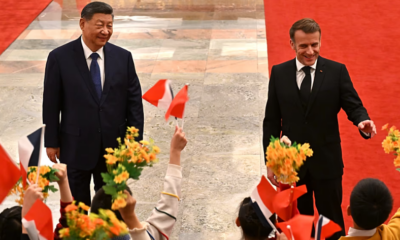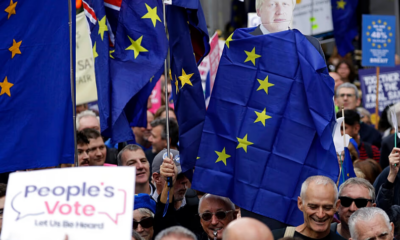Business
Trump warns US could be left ‘defenceless’ if Supreme Court overturns global tariffs

US President Donald Trump has cautioned that the United States could be left “defenceless” and “reduced to almost Third World status” if the Supreme Court overturns his sweeping global tariffs. The warning came as justices appeared sceptical during oral arguments on Wednesday about his claims of near-unlimited authority to impose tariffs.
Despite the court’s doubts, trade experts say Trump would still have multiple legal tools to continue taxing imports even if his emergency powers are curtailed. “It’s hard to see any pathway here where tariffs end,” said Kathleen Claussen, a trade law professor at Georgetown University. “He could rebuild the tariff landscape using other authorities.”
Tariffs have become a key element of Trump’s foreign and economic policy in his second term. Since returning to the White House, he has imposed double-digit “reciprocal” tariffs on most countries, declaring America’s trade deficits a national emergency. The average US tariff now stands at 17.9%, up from 2.5% in January, according to Yale University’s Budget Lab — the highest level since 1934.
At the hearing, Neal Katyal, representing small businesses challenging the tariffs, argued that Trump’s use of the 1977 International Emergency Economic Powers Act (IEEPA) went far beyond what Congress intended. He noted that Congress had already delegated tariff powers through other, more limited laws. “Congress knows exactly how to delegate its tariff powers,” Katyal said.
Even if the Supreme Court restricts his use of emergency powers, Trump could turn to several other laws to keep tariffs in place. Section 301 of the Trade Act of 1974 allows the United States to impose duties on countries engaged in “unjustifiable” or “unreasonable” trade practices. Trump has used it extensively against China, including tariffs on a wide range of goods during his first term. These measures can last four years and be renewed indefinitely.
Another option is Section 122 of the same act, which lets the president impose tariffs of up to 15% for 150 days in response to trade imbalances. Though never used before, this provision requires no investigation before implementation.
Trump has also relied heavily on Section 232 of the Trade Expansion Act of 1962, which allows tariffs on imports deemed a threat to national security. Using this authority, he has imposed duties on steel, aluminium, and even furniture, a move that critics argue stretches the definition of “security.” Courts are generally reluctant to question presidential determinations in this area, giving the White House considerable latitude.
Some advisers have floated an even older tool: Section 338 of the Tariff Act of 1930, part of the infamous Smoot-Hawley legislation that deepened the Great Depression. The clause permits tariffs of up to 50% against countries that discriminate against US businesses. Though it has never been used, Treasury Secretary Scott Bessent recently described it as a potential “Plan B” should the Supreme Court strike down Trump’s emergency tariffs.
“To be the first president ever to use it could have some cachet,” said John Veroneau, a former US trade official. For now, Trump’s message to the court — and to trading partners — is clear: even if one door closes, he intends to keep the tariff war alive.
Business
Silver Surges Past $60 as Supply Strains, Rate Expectations and Tariff Concerns Drive Rally

Silver prices have surged to levels not seen before, rising above $60 an ounce this week after months of rapid gains driven by tightening supply, shifting Federal Reserve expectations and uncertainty around potential US trade actions. The metal hovered near $62 on Wednesday, extending a rally that began early this year when prices averaged around $30.
The latest jump came ahead of the Federal Reserve’s meeting, where investors expect another cut to the benchmark interest rate. The timing of the central bank’s leadership transition has added another layer of speculation. The US administration is reviewing finalists to replace Jerome Powell as chair, with Kevin Hassett, a senior economic adviser during Donald Trump’s presidency, reported to be the leading contender.
Market analysts say the candidates under consideration favour sharper rate reductions than those overseen by Powell. Since September, the Fed has trimmed rates twice by a quarter point each time. The gentler pace of easing has already pressured returns on cash and fixed-income assets, prompting many investors to shift into precious metals, which typically attract interest when rates fall. Silver, which does not generate yield, becomes more appealing in such an environment. Its performance has even outpaced gold, which has risen about 60 percent this year to reach record highs.
At the same time, traders are monitoring signals from Washington about whether silver could be targeted with tariffs. The metal was added in early November to the US government’s 2025 Critical Minerals List, a classification usually applied to resources seen as essential for national economic security. The designation places silver within the range of potential Section 232 investigations, the mechanism used in past years to justify tariffs on imported steel and aluminium.
Section 232 allows restrictions on imports deemed to put the country at risk through heavy dependence on overseas supply. No investigation has been launched, and officials have not indicated that tariffs are imminent. Still, the possibility has unsettled markets. Any duties on imported silver could reshape trade patterns and raise costs for domestic manufacturers, leading some buyers to boost inventories as a precaution.
Industrial use is also adding upward pressure. Demand from electric vehicle and solar panel manufacturers continues to rise, with these sectors relying on silver for components essential to production. Industrial consumption represents more than half of global silver use, and the combination of tight supply and strong manufacturing needs has intensified the rally.
Analysts say the market remains highly sensitive to signals from the Fed and the White House, with both interest-rate policy and trade decisions poised to shape the direction of prices in the months ahead.
Business
US Allows Nvidia to Sell H200 Chips to Approved Chinese Customers With 25% Surcharge
Business
Gold Looks to 2026 After a Record-Breaking Year Marked by Geopolitical Tension and Strong Central Bank Demand
-

 Entertainment1 year ago
Entertainment1 year agoMeta Acquires Tilda Swinton VR Doc ‘Impulse: Playing With Reality’
-

 Business2 years ago
Business2 years agoSaudi Arabia’s Model for Sustainable Aviation Practices
-

 Business2 years ago
Business2 years agoRecent Developments in Small Business Taxes
-

 Home Improvement1 year ago
Home Improvement1 year agoEffective Drain Cleaning: A Key to a Healthy Plumbing System
-

 Politics2 years ago
Politics2 years agoWho was Ebrahim Raisi and his status in Iranian Politics?
-

 Business1 year ago
Business1 year agoCarrectly: Revolutionizing Car Care in Chicago
-

 Sports1 year ago
Sports1 year agoKeely Hodgkinson Wins Britain’s First Athletics Gold at Paris Olympics in 800m
-

 Business1 year ago
Business1 year agoSaudi Arabia: Foreign Direct Investment Rises by 5.6% in Q1





























